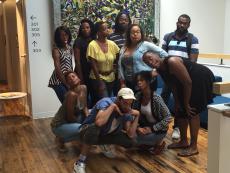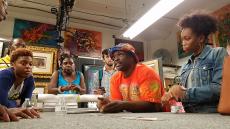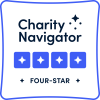Have you been wondering, just what the Urban Arts Leadership Program (UALP) is?
Here’s what our 2016/2017 Cohort has to say about the UALP!
Why did you join UALP?
 Miriah Garnett:
Miriah Garnett:
When I applied for the Urban Arts Leadership Program, I was a senior at The University of Maryland, Baltimore County and was about to graduate. I was looking for the next step in my career. I had a passion for the arts and had many leadership positions throughout my life, especially in college, so arts management was a career I was looking into. Luckily, the art department at my school sent out an email for an info session about UALP. After reading through it, attending the session, and doing some research, I realized that this was exactly what I was looking for.
Omari Russel:
I felt that its initiatives to promote racial equity in arts leadership complimented my interests in the arts and advocacy. I was looking to expand my horizons and hone my abilities so I that I could become a more effective representative of underprivileged communities.
Janica Alston:
I was hoping to develop a deeper connection to the artists of other disciplines in Baltimore. Developing this connection will help me better navigate and serve the community.
The First Half of the Fellowship includes a weekly Professional Development Series. What was your biggest takeaway from these workshops?
Kiara Nicole:
My favorite moment was meeting the students from "Save A Dope Boy” and having one of the students be able to teach us his form of dance. It's so important to build positive relationships with the youth, especially in a city like Baltimore. I feel like he felt welcomed and I saw him opening up to us.
Juansebastian Serrano:
The grant writing session was exquisite to say the least. I took away huge practical and logistical facets of writing a great proposal, which I recently used in a proposal I wrote for Artscape this year.
Lenee Freeman:
My favorite professional development workshops were the ones facilitated by Larry Poncho Brown. I learned so much from Poncho, including how he's been surviving as an artist for all these years. It was an awakening moment to realize that some of the things he spoke of I've been doing on and off for the last few years, but never thought of myself as an entrepreneur. After those workshops I've begun to be more selective about my artwork, how I present it, and where I present it (and to make sure I post the cost if someone wants to buy it).
What are you looking forward to or currently enjoying about your Organizational Placements
 Kiara Nicole:
Kiara Nicole:
I'm looking forward to be able to produce work that continues with the organization even if I don't.
Raina Almond:
In the short period of time I have been at Young Audiences, they have treated me like their own and given me every possible opportunity without it feeling like an overload.
Juansebastian Serrano:
I had always been able to balance a spreadsheet, but never for something as serious or complex as what is needed for the Baltimore Office of Promotion and the Arts (BOPA). I have learned various tricks on Excel, and have striven to bring in my design background to develop information formats that will be easier for all staff to digest. I have also had the opportunity to bring in my curatorial and art-handling background, having been given the task of being the Production Assistant for LABS @LightCity.
Lenee Freeman:
I'm looking forward to being around creative people and learning from them.
Why is UALP important?
Kiara Nicole:
UALP provides young artists/art administrators of color the opportunity to gain insight into the lack of equity and inclusion in the arts sector. It also forces these organizations to look at themselves and see in what ways they have been problematic regarding issues of equity and inclusion. We need more of a platform to really speak on the issues plaguing arts communities on a larger scale.
Raina Almond:
UALP takes people of color from all walks of life with a focus on art and expands their horizons to a point that may not have been done otherwise. Not only does it benefit us, but we have been blessed to impact others lives as well.
Janica Alston:
This program is important because it gives artists of color an opportunity and a voice in their own community. Far too often, there are artists of other ethnic backgrounds speaking about and working in a community that they know nothing about. UALP fellows are given the opportunity to collaborate and create their own network that will benefit artists and arts organizers in the future.
How have you grown over the course of the program?
 Kenneth Clemons:
Kenneth Clemons:
I'm a work in progress which is why I continue to evolve both as a member of the UALP cohort and as an artist. I’d say that I’ve begun to develop an understanding of leadership. I believe the learning process from within is not only ongoing; in fact, an everlasting mission that must be nurtured with care. Each of the fellows are personally evolving successfully within the program through our different placement sites.
Raina Almond:
As a cohort, I feel we have just become undeniably a force to be reckoned with. We take on situations thrown at us with a creative mindset without stepping on each other's toes and the results are always amazing.
Lenee Freeman:
I'm more aware of myself, the skills I can offer, and how networking with others in the community can bring change and awareness.
Juansebastian Serrano:
Stronger, reassured in my talents, worth, and what I bring to the table as a person of color.
Anything else you would like to tell the world about being a 2016/2017 UALP Fellow?
Omari Russel:
UALP has made me think in more tangible terms. Specifically, in ways that I can implement my abilities in real-world situations. UALP bridges the imaginative being of the artist and the real needs of Baltimore.
Kenneth Clemons:
Expect the unexpected! The program will give you your own personal insight into yourself. Just when you climb that mountain top of personal success, there's an even higher peak to climb.
Miriah Garnett:
Before becoming a UALP fellow, I thought I was involved in my community and had an understanding of what the art scene looks like in Baltimore. However, after working with my host site, Baltimore Arts Realty Corporation, I experience new things about Baltimore and its arts community everyday. It's enlightening and exciting to have a much deeper understanding of Charm City.
Applications for the 2017/2018 Urban Arts Leadership Program are now open.

 Miriah Garnett:
Miriah Garnett: Kiara Nicole:
Kiara Nicole: Kenneth Clemons:
Kenneth Clemons:
